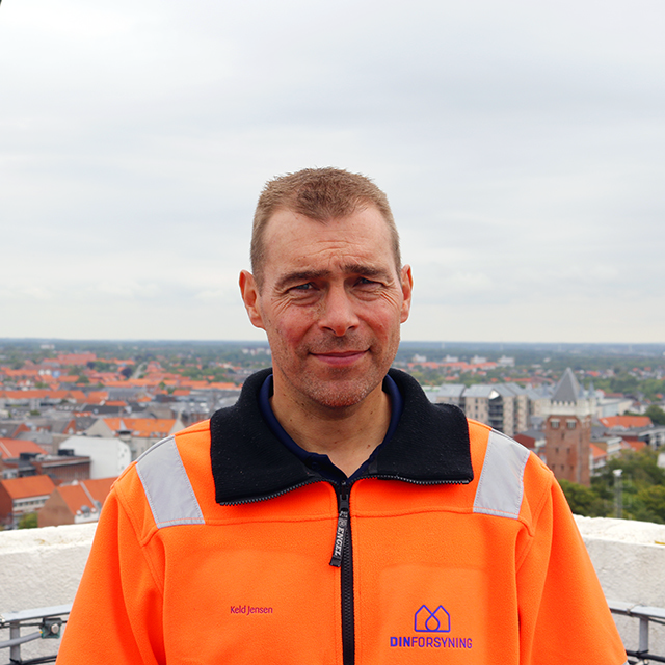
70% fewer antenna sites
DIN Forsyning, Denmark
Using the new meter reading method linkIQ®, DIN Forsyning was able to significantly reduce the number of required antenna sites in the city of Esbjerg. The field test met the utility’s high expectations and has paved the way for simpler work routines, better customer service and a more efficient utility.
In the summer of 2019, when DIN Forsyning faced the challenge of optimising its meter reading system in the city of Esbjerg, they jumped at the opportunity when Kamstrup proposed they test a completely new meter reading method. The West Jutlandic utility had a number of meters which could not be read by their existing solution. “Our ambition is that we capture all of the data by remote reading. If there are too many meters in the area that we cannot access, then we have to look what we can do,” explains Operations Manager Keld Jensen.
Using Kamstrup’s new meter reading method linkIQ® would require 70% fewer antenna sites to read all of the meters in the project compared to a traditional network based on the Wireless M-Bus standard. A field test was therefore carried out to confirm the improved performance of the new method.

Simpler work routines and improved service
Today DIN Forsyning has a number of different meters and systems, due in part to the merger of several different companies and because there are significant differences across the supply area. “There is concrete everywhere in Esbjerg, there are large residential districts made up of single-family homes in the smaller towns, countryside with hills and valleys and large distances between neighbours. It requires different types of remote reading,” explains Keld Jensen. Today there are several types of meter with their own system but the utility is working to collect all incoming data from Kamstrup in a single system, thus eliminating the need to have several different user interfaces.
The utility’s considerations included the opportunity to find a solution to the challenge its customer service currently faced – being partially dependent on which type of meter, which generation of meter and meter software that the customer has. For example, it applies to guidance in relation to any motivation tariff. “Our customers are using over 20 different menus and user interfaces and that’s a problem. So the more uniform things become the easier it becomes to advise customers.” Maintenance was also looked at, because it is important for the utility to limit the number of man hours spent on service and repairs.
The structured test approach ensures learning
There were high expectations with the test from the very beginning. “We had high expectations with the transmission power. The meters that we have, which are located in wells or deep within wardrobes, utility rooms or basements, must be read without us having to visit sites and install extra antennas. And having contact with the meters only when the wind is blowing in the right direction in good weather is not good enough,” says Keld Jensen.
The field test ran for two months and covered three antenna sites and 50 meters, of which 34 were alternately installed in the homes of approximately 90 DIN Forsyning employees in order to test different scenarios. Everyone involved filled out a form describing the type of home they lived in, the year the home was built, which room the meter was located in, whether there were windows, etc. This information was used to build a precise picture of the different conditions that affected the test. To challenge the radio signal, the utility also used a number of locations where they knew from experience it was difficult to get data back from.
A range of 7 km
According to Keld Jensen, the field test results surpassed expectations, especially because of the challenging locations of some of the meters and because basically all of the meters could be read without the use of extra antennas. “I was positively surprised – very surprised in fact. “We’ve had meters in installations where we were unable to get data using the drive-by meter reading method, practically regardless of where we stopped – and not with well antennas either. But with linkIQ®, we got the data every time. And in Esbjerg hospital’s two-storey basement, where to all intents and purposes we couldn’t get a Radio Mesh signal out, the meters returned data using linkIQ® and without an antenna.
Meters were read from distances of up to 7 km and on the basis of the positive results, DIN Forsyning decided to install the system in the remaining eight sites – a decision that has generated significant savings. “With linkIQ®, we need to use far fewer antenna sites in the city. This is significant in terms of purchasing but also in relation to the subsequent service and maintenance, and above all, for the annual site rental costs for the many buildings our antennas are on,” explains Keld Jensen.
The new network also saves money because it can receive data from several of DIN Forsyning’s existing meters. “Many of our existing meters also send data via the new network, which is a huge advantage because it means we avoid having to replace the entire meter network. It’s also just a more robust system, with fewer potential faults.”

About the solution
Kamstrup developed linkIQ® in order to deliver wireless communication via a fixed network, which is used for the remote reading of smart water meters and heat meters. LinkIQ® is designed with the aim of creating a robust network with a large range and few components, which can deliver the quantities of data that modern utilities require.
Efficiency drives us
This is not the first time that DIN Forsyning has been among the first to try something new. The utility has undergone impressive development over many years; from primarily reading meters manually, using thousands of handwritten meter reading cards, to reading them via refuse collection trucks, to being one of the very first utilities to use a radio network and now to using completely new meter reading technology.
“We must administer the customers’ money in the best possible way, so we’re always looking to see if we can make an investment today that will save money in a couple of years’ time. But it is efficiency that drives us. If a completely new system can do all sorts of things but requires that we replace all of our meters again or employ three more people, then it does not make sense,” says Keld Jensen.
According to Keld Jensen, the linkIQ® project has shown the importance of choosing the correct partner, especially when doing something new. “Our collaboration with Kamstrup has been excellent. Of course, there were times when we disagreed or where the test showed something other than we’d hoped for – that’s the way it is with completely new things. But we talked about it and we solved the problems.”
DIN Forsyning has major plans for its meter data once full system rollout has taken place – for the benefit of both the utility and the customers. “We want to look at how we can use the data to secure our network and trace leaks and how we can get leak alarms from the meters out to the customers. We also want to be able to show more meter data in our customer portal, so we can advise customers about consumption and optimisation more individually. There are lots of options,” says Keld Jensen.












